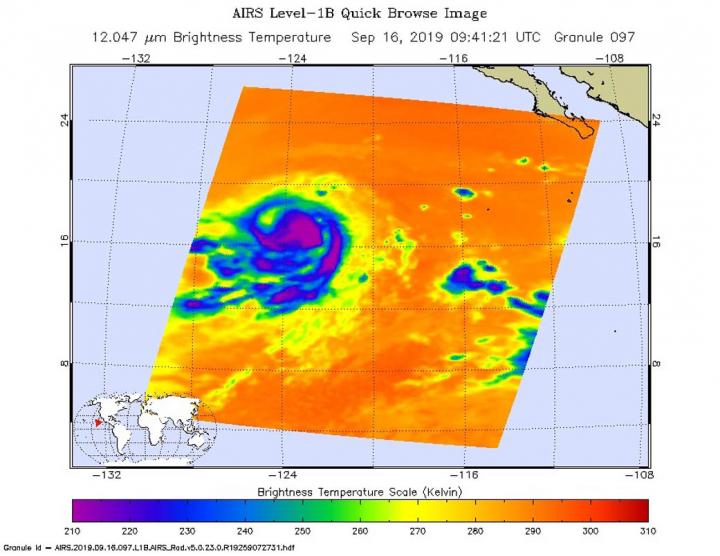
Credit: NASA JPL/Heidar Thrastarson
NASA’s Aqua satellite provided forecasters at the National Hurricane Center with infrared data and cloud top temperature information on Hurricane Kiko. Wind shear was affecting the storm and had closed the eye.
On Monday, September 16, 2019, microwave data and satellite imagery continue to indicate that the core of Kiko is being disrupted. Wind shear from the northeast is preventing Kiko from having a closed eyewall circulation. That means that the storm is subject to outside winds and can weaken.
NASA researches tropical cyclones. One of the ways NASA does that is with infrared data that provides temperature information. Cloud top temperatures provide information to forecasters about where the strongest storms are located within a tropical cyclone. Tropical cyclones do not always have uniform strength, and some sides have stronger sides than others. The stronger the storms, the higher they extend into the troposphere, and they have the colder cloud temperatures.
NASA’s Aqua satellite analyzed the storm on Sept. 8 at 11.59 p.m. EDT (Sept. 9 at 0359 UTC) using the Atmospheric Infrared Sounder or AIRS instrument. The AIRS instrument is one of six instruments flying on board NASA’s Aqua satellite, launched on May 4, 2002.
The AIRS infrared data no longer showed an eye in Kiko, indicating that the wind shear from the northeast had filled the center with clouds.
In general, wind shear is a measure of how the speed and direction of winds change with altitude. Tropical cyclones are like rotating cylinders of winds. Each level needs to be stacked on top each other vertically in order for the storm to maintain strength or intensify. Wind shear occurs when winds at different levels of the atmosphere push against the rotating cylinder of winds, weakening the rotation by pushing it apart at different levels.
AIRS found coldest cloud top temperatures as cold as or colder than minus 63 degrees Fahrenheit (minus 53 degrees Celsius) around Kiko’s center and in a large bands east and west of center. NASA research has shown that cloud top temperatures that cold indicate strong storms that have the capability to create heavy rain.
At 11 a.m. EDT (1500 UTC), the center of Hurricane Kiko was located near latitude 17.3 degrees north and longitude 123.7 degrees west. That put the center about 975 miles (1,570 km) west-southwest of the southern tip of Baja Calfiornia, Mexico. Kiko is moving toward the west near 5 mph (7 kph), and this motion is expected to continue through tonight.
Maximum sustained winds have decreased to near 105 mph (165 kph) with higher gusts. Kiko is a small tropical cyclone. Hurricane-force winds extend outward up to 15 miles (30 km) from the center and tropical-storm-force winds extend outward up to 60 miles (95 km). The estimated minimum central pressure is 971 millibars.
NHC forecasters expect a west-southwestward motion on Sept. 17 followed by a turn back to the west on Wednesday. Gradual weakening is expected during the next couple of days.
###
For updated forecasts, visit: http://www.
Rob Gutro
NASA’s Goddard Space Flight Center
Media Contact
Rob Gutro
[email protected]
Original Source
https:/




